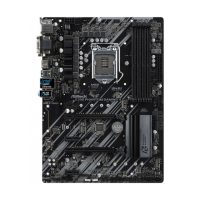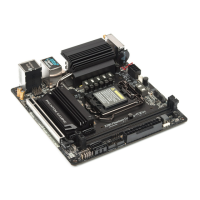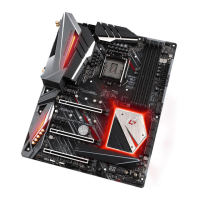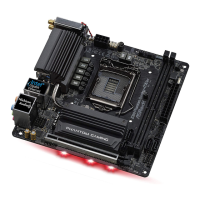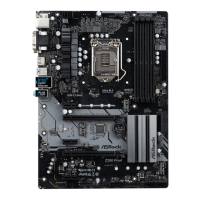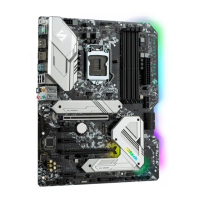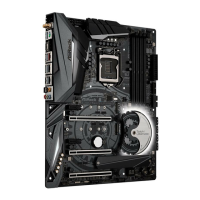Do you have a question about the ASROCK Z390 Phantom Gaming 4S and is the answer not in the manual?
Lists all items included in the motherboard package.
Details the technical specifications of the motherboard and its components.
Provides a visual diagram of the motherboard components and connectors.
Identifies and describes the rear panel input/output connectors.
Outlines essential safety and handling guidelines before installing components.
Step-by-step instructions for correctly installing the CPU into the socket.
Guide for mounting the CPU cooler assembly onto the motherboard.
Instructions on how to properly insert DDR4 DIMM modules into the slots.
Explains the types and configurations of the PCI Express expansion slots.
Details the function and configuration of jumpers, like the Clear CMOS jumper.
Identifies and describes various onboard headers for system panel and other connections.
Explains the function of the Post Status Checker for diagnosing boot issues.
Instructions for setting up multi-GPU configurations using AMD CrossFireX technology.
Guide for installing M.2 wireless and Bluetooth modules.
Step-by-step instructions for installing M.2 NVMe or SATA SSDs.
Describes how to install necessary drivers and utilities from the support CD.
Overview of ASRock's tuning utility for system performance and fan control.
Instructions for downloading and installing the Phantom Gaming Tuning software.
Explains the features and sections within the Phantom Gaming Tuning utility.
Introduces the online store for downloading ASRock software and utilities.
Describes the user interface layout of the ASRock Live Update & APP Shop.
Details how to browse and install applications from the APP Shop.
Explains how to update BIOS and drivers using the ASRock Live Update utility.
Describes the settings available in the ASRock Live Update & APP Shop, such as language.
Guide for controlling RGB lighting effects on the motherboard.
Introduces the UEFI BIOS setup utility and how to access it.
Explains the default EZ Mode interface for basic system monitoring and settings.
Introduces the Advanced Mode for detailed BIOS configuration options.
Describes the main menu bar options within the UEFI setup utility.
Lists and explains the keyboard shortcuts used for navigating the UEFI utility.
Details the system overview displayed on the Main screen of the UEFI utility.
Explains the OC Tweaker section for system overclocking configurations.
Overview of the Advanced section containing various system configuration categories.
Settings related to CPU features, core control, and power-saving states.
Configuration options for the motherboard chipset and PCI Express settings.
Settings for managing SATA controllers, RAID, and SMART features.
Configuration options for Intel Thunderbolt ports and related features.
Settings for Super IO devices like serial ports and their addresses.
Configuration options for ACPI features like power management and wake-up events.
Settings for managing USB ports and legacy USB support.
Configuration for managing RAID volumes using Intel RST.
Access to various utility tools within the UEFI, like Instant Flash.
Displays system hardware status, including temperatures, fan speeds, and voltages.
Settings for system passwords, Secure Boot, and Intel PTT.
Configuration for boot order, fast boot options, and boot-related settings.
Options for saving changes, discarding them, and exiting the UEFI utility.
| Processor socket | LGA 1151 (Socket H4) |
|---|---|
| Processor manufacturer | Intel |
| Compatible processor series | - |
| Non-ECC | Yes |
| Memory slots type | DIMM |
| Number of memory slots | 4 |
| Supported memory types | DDR4-SDRAM |
| Maximum internal memory | 128 GB |
| Supported memory clock speeds | 2133, 2400, 2666, 2800, 2933, 3200, 3600, 3733, 3800, 3866, 4000, 4133, 4300 MHz |
| RAID levels | 0, 1, 5, 10 |
| Supported storage drive interfaces | SATA III, Ultra M.2 |
| DirectX version | 12.0 |
| Maximum resolution | 4096 x 2160 pixels |
| Parallel processing technology support | CrossFireX, Quad-GPU CrossFireX |
| USB 2.0 connectors | 2 |
| Number of COM connectors | 1 |
| Number of SATA III connectors | 6 |
| USB 3.2 Gen 1 (3.1 Gen 1) connectors | 0 |
| HDMI version | 1.4 |
| USB 2.0 ports quantity | USB 2.0 ports have a data transmission speed of 480 Mbps, and are backwards compatible with USB 1.1 ports. You can connect all kinds of peripheral devices to them. |
| Wi-Fi | No |
| Ethernet interface type | Gigabit Ethernet |
| Audio chip | Realtek ALC1200 |
| Certification | FCC, CE |
| Component for | PC |
| Motherboard chipset | Intel Z390 |
| PC health monitoring | FAN, Temperature, Voltage |
| Audio output channels | 7.1 channels |
| Motherboard form factor | ATX |
| Windows operating systems supported | Windows 10 x64 |
| BIOS type | UEFI AMI |
| ACPI version | 6.0 |
| BIOS memory size | 128 Mbit |
| System Management BIOS (SMBIOS) version | 2.7 |
| PCI Express x1 (Gen 3.x) slots | 3 |
| Depth | 213 mm |
|---|---|
| Width | 305 mm |
